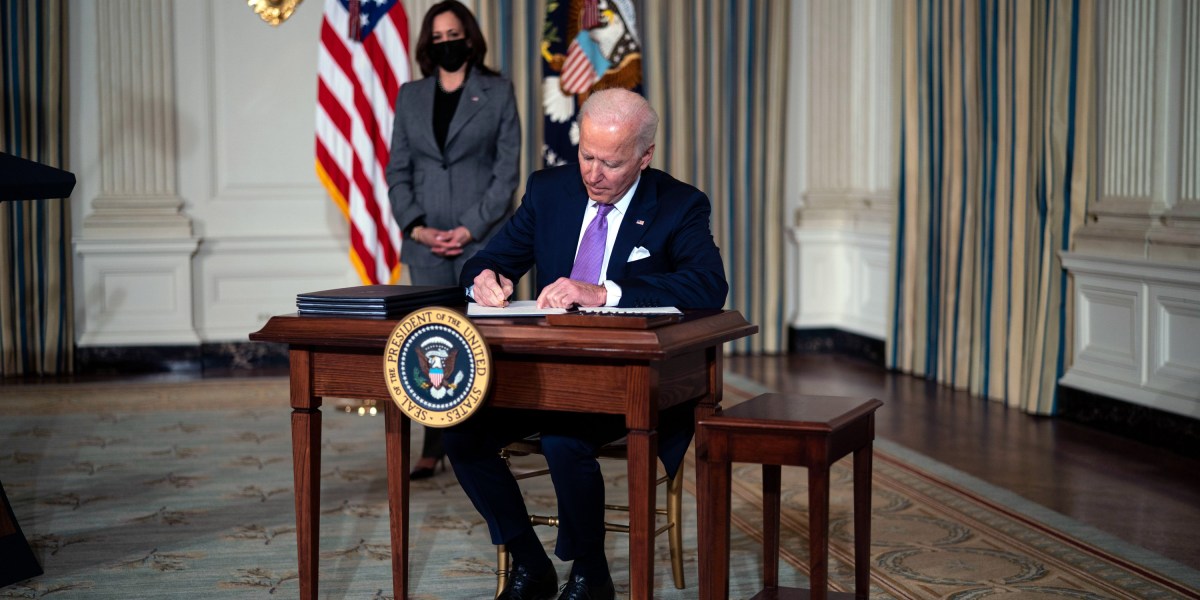Biden directs billions in federal spending power to climate change

President Joe Biden continues to make good on his campaign pledge to accelerate progress on climate change, rapidly working down the list of what he can accomplish on his own in his early days in office.
On Wednesday, January 27, he will sign a second set of executive orders and memorandums on climate change that direct federal agencies to purchase US-made, zero-emissions vehicles and carbon-free electricity, halt nearly all new oil and gas leases on public lands, and eliminate fossil fuel subsidies.
Biden also placed climate change at the center of national security planning, requiring federal agencies to evaluate how increasingly severe heatwaves, fires, flooding and famines could inflame global conflicts. The actions will also begin the process of creating new climate emissions reductions targets for the US under the Paris climate agreement.
The latest directives follow Biden’s climate actions on his first day in office, which included kickstarting the process of rejoining the Paris agreement and establishing new regulations on methane emissions, vehicle fuel economy standards and much more.
A big market boost
The orders will provide a major boost to the domestic market for renewables like wind, solar and geothermal plants as well as electric or hydrogen vehicles. It will direct billions of federals dollars to these industries while creating regulatory certainty that will make it easier to finance new projects and factories, says Josh Freed, who leads the climate and energy program at Third Way, a center-left think tank in Washington, DC.
The vehicle order, for instance, could eventually add up to around 650,000 government cars, trucks and buses, potentially increasing the size of the domestic market by nearly 40%. Only an estimated 1.6 million plug-in electric vehicles had been sold in the US as of late last year, and fewer than 10,000 hydrogen vehicles since 2012, according to InsideEVs.
Agencies, however, will likely only replace vehicles as they reach the end of their useful lives, so the full turnover will surely take years.
It’s not yet clear how the order to buy clean electricity will work or what it achieve at this stage, including whether it will require agencies to obtain a certain percentage or all of their electricity through low-carbon sources like wind, solar and nuclear power. It’s also not immediately apparent how government agencies will reach those goals given limited control over the mix of sources generating electricity on local grids.
Erin Sikorsky, deputy director of the Center for Climate and Security in Washington, D.C., applauded the order’s focus on national security.
Without incorporating detailed assessments of shifting climate conditions, the US won’t recognize the potential for regional conflicts that can stem from things like prolonged droughts; can’t properly prepare and equip its overseas troops and bases; and won’t grasp how power dynamics are likely to shift among nations and non-state actors, she says. For instance, famines could increase recruitment among terrorist groups and warming conditions could boost the economic output and regional influence of countries like Russia.
Elevating environmental justice
The new executive orders included numerous additional directives and announcements. Among them:
- Biden will host a climate summit with other world leaders on April 22, Earth Day. It’s a clear bid to reset the nation’s international climate diplomacy efforts.
- Biden also directed agencies to take steps to address the outsized impact of environmental and climate threats on disadvantaged communities, and to ensure they receive 40% of the benefits from any related federal investments.
- The president also directed the Secretary of Agriculture to begin exploring ways of encouraging farming practices that can reduce emissions and store more carbon in soil; and called for the creation of a Civilian Climate Corps Initiative to put Americans to work planting trees and otherwise restoring public lands and waters.
- A new memorandum elevates the role of science and expertise in federal policy making, directing agencies to “make evidence-based decisions guided by the best available science and data.”
- Biden also set up or reestablished numerous climate and science advisory groups, including the White House Environmental Justice Advisory Interagency Council and a National Climate Task Force that will pull leaders from 21 agencies and departments.
The limits of executive orders
At this stage, Biden is effectively checking off the things he can accomplish on climate change through executive orders, rather than pushing new laws through Congress.
But there are limits on how much he can achieve through this approach. Executive orders are effectively instructions on how federal agencies should operate, but they can’t reverse existing laws or create new powers for the presidency. Presidents also generally can’t spend money that Congress hasn’t already authorized, although they can direct how it’s spent, as Biden seems to be doing with clean electricity and vehicles.
The precise boundaries of what can and can’t be achieved through executive orders is a subject of heated debate and frequent court challenges. The other downside is they can also be unilaterally overturned from one administration to the next, as Trump did with many of President Barack Obama’s orders and Biden is now doing with Trump’s.
Accelerating the shift to zero-emissions technologies enough to prevent 2˚C of warming, the stated goal of the Paris agreement, will clearly require legislation. The real climate test for Biden’s climate agenda will be whether he can get that done with only slim Democratic control of the Senate.
